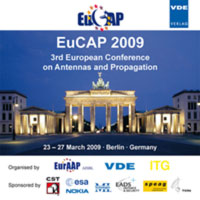Study of Small-Size Stacked Fabry-Perot Cavities for Focal Array Applications
Conference: EuCAP 2009 - 3rd European Conference on Antennas and Propagation
03/23/2009 - 03/27/2009 at Berlin, Germany
Proceedings: EuCAP 2009
Pages: 5Language: englishTyp: PDF
Personal VDE Members are entitled to a 10% discount on this title
Authors:
Muhammad, S.A.; Sauleau, R. (IETR (Institut d’Electronique et de Télécommunications de Rennes), UMR CNRS 6164, Université de Rennes 1, Campus de Beaulieu, Avenue du Général Leclerc, 35042 Rennes Cedex, France)
Legay, H. (Thales Alenia Space, BP 1187, 31037 Toulouse Cedex 1, France)
Abstract:
Compared to classical horns, purely metallic Fabry-Perot (FP) antennas are of special interest for space applications thanks to their low profile and high-power handling capabilities. In this context, a new broadband configuration of FP antennas is introduced here. It consists of two coupled stacked metallic FP resonators with different sizes and Q-factors. Such a configuration enables one to achieve larger radiation bandwidth and better impedance matching than standard single-cavity FP antennas. Here each cavity is shielded by four Perfect Electric Conductor (PEC) side walls and is covered by an inductive Frequency Selective Surface (FSS). An extensive numerical study has been carried out to optimise each FSS reflectivity, and obtain the largest possible bandwidth simultaneously in impedance and radiation. In this paper several small-size FP antennas (1.85x1.85 λ2) are presented and compared at 12.6 GHz. We show that the stacked configuration enables one to achieve an overall bandwidth of 11% with a reflection coefficient lower than -15 dB, very stable radiation patterns and high aperture efficieny (>70%), even when using grids with very low reflectivity. The proposed configuration also allows reducing the parasitic effects of higher modes that are always excited in single-cavity shielded FP antennas.


